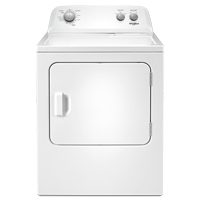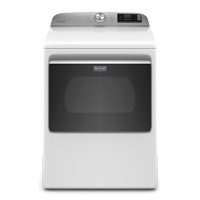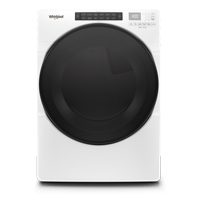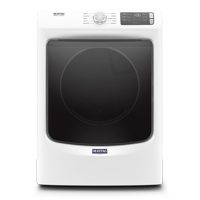
Table of Contents

Planning considerations
Decide on Your Preferred Set-up

Available Space
Stackable
- If you live in an apartment or condo, you need to get creative and use whatever space is available. This is a combo set consisting of a front load washer and dryer. These machines are stacked, freeing up valuable real estate in your home.
- Typical width of a washer and dryer is around 27″ (69 cm). It doesn’t require too much space and could even be installed in a closet.
- The dryer will always be on top because of the weight difference.
Side by side
- This is a common set-up where the dryer is next to the washer. This requires more room, so you must map out the functionality of the room before making your purchase.
- This may require at least 54″ (137 cm) of space across the room if both machines are around 27″ (69 cm). Consult the installation instructions for required space.
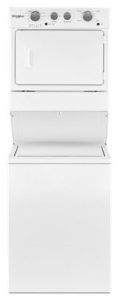
Save valuable floor space with a stacked laundry centre from Whirlpool brand
With the dryer placed atop the washer, a stacked laundry centre can even fit in a closet.
What is your budget?
- Regardless of your budget, there is a dryer for you! Often, buying a washer and dryer pair can save you money. Prices can range based on features, which can include larger capacity and smart/Wi-Fi connectivity, among others.
How often do you do laundry?
- Consider frequency when it comes to quality, cost of maintenance, and electricity bills. Fortunately, many machines are ENERGY STAR® certified, meaning they run on less power.
See this Quick Video Guide on Choosing a Dryer to Help Guide Your Search

Types of dryers
Gas
- Top load matching and front load options are available.
- A physical set-up needs to be available through a gas line that will connect with the dryer. It is recommended that you consider a certified gas technician when installing a gas dryer.
- Gas heats up faster resulting in a shorter drying time.
Electric
- Top load matching and front load options are available.
- Electric dryers do not need gas lines to work. The set-up is considered to be easier.
- Electricity typically does take longer to warm up than gas, so the drying time can be a bit longer. Explore this helpful guide to help you decide if a gas or electric dryer is best for your home.
Vented (Electric)
- The machine will require an exhaust vent to be installed through an exterior wall. If you live in an apartment or condo, this will likely not be possible so it is important to ensure you consider a ventless model.
- Buying a vented machine will also limit where you can install your dryer.
Ventless (Electric)
- These appliances do not require a hookup to an exhaust vent, giving you the flexibility to install it wherever you want.

Configuration / Style
Top Load
Though it is commonly referred to as a “top load” because it pairs with a top load washer, the loading door is actually positioned in the front of the machine. Top load dryers are usually designed to mimic top load washers delivering a similar look with respect to button placement and design.
Sizing/capacity
- The smaller the drum size, the less laundry you can dry per load. More capacity allows for more laundry to be dried in a single load. Larger households often choose more capacity. Ultimately, it’s about finding the right solution for your needs.
- More capacity will generally cost more and requires more space. Consider your budget and the available installation space when deciding.
- Average cubic feet for tub capacity ranges from 7 to 7.4.
- Certain dryers are a lot smaller, allowing them to fit into tighter spaces and making them a good choice for apartments and condos. This may increase the number of loads needed to dry clothes (ranging from 3.4 to 4.3 cubic feet including ventless dryers). Finding the right compact laundry solution for your home is easy with our helpful guide to Washer and Dryer Combos for Tight spaces.
- Measurements: The average height of these dryers is 38″ to 43″ (86.36 cm to 109.22 cm), with an average width of 27″ (68.58 cm), and an average depth of 28″ to 34″ (71.12 cm to 86.36 cm).
Side Swing Door vs. Hamper Door
Side Swing
- Based on the model you buy, the door can swing from either the right or left. Many models can be reversed to suit the layout of your laundry room or space.
- An easier way to reach the drum.
- Allows you to put your laundry basket underneath the open drum so you can unload your laundry.
Hamper Door
- Hamper doors are sturdy and versatile, designed to keep clean clothes from falling on the floor.
- Dryers with hamper doors are an option regardless of whether they’re installed to the right or to the left of your washer.
- Provides a useful surface for easily folding freshly cleaned clothes without moving them somewhere else.
- Certain dryers allow you to position the latch-free door in one of two ways to easily load your laundry.
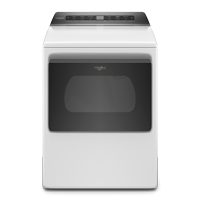
Make laundry day easy
Load, unload and fold your laundry using the dryer’s door as a shelf. Explore the handy design of a Whirlpool® hamper door dryer.
Front Load
Sizing/Capacity
- The smaller the drum size, the less laundry you can load. More capacity allows more clothes to be dried in a single load. Larger families often go for a bigger tub, but it always comes down to your needs.
- More capacity will typically also increase the price and the space needed. Base this decision on your budget and the available installation space.
- Average cubic feet for tub capacity ranges from 7 to 7.4.
- Some dryers are much smaller so that they can fit in tighter spaces like apartments and condos. This will increase the number of loads to dry (ranging from 3.4 to 4.3 cubic feet including ventless dryers).
- Measurements: The average height of these dryers is 38″ to 43″ (86.36 cm to 109.22 cm), with an average width of 27″ (68.58 cm), and an average depth of 28″ to 34″ (71.12 cm to 86.36 cm).
Reversible Doors
- Many dryers have the option to reverse the way the door swings. Please refer to the owner’s manual to find out if yours can do this. It is usually recommended to have the door open away from walls or cabinets so that it doesn’t hit them.
All-in-one options
- A machine that can wash and dry all in one. This is great for tight places like bathrooms or inside a closet. This will free up your available space and, since it can be ventless, it can be moved to other places to better suit you and your space.
Prices vary. They typically increase as more features and options are added, like a stainless steel tub.
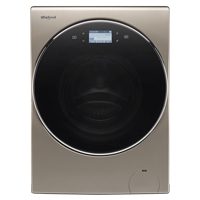
Limited on space?
An All-in-One washer and dryer from Whirlpool brand could be the ideal solution for your laundry centre. Save space and time by loading only once.
Ventless Options: Heat pump vs. Condensing
- If you choose to go with a ventless option, you will have to decide between a heat pump or condensing dryer. A heat pump typically cuts down on energy by recycling the air to dry clothes. It can take longer to dry, but can also save you money over time thanks to its energy efficiency. A condensing dryer utilizes water condensation drying technologies to get clothes dry. Rest assured that both of these options will dry your clothes; the difference is how they generate heat.

Features to consider
Steam
-
- Releases wrinkles without rewashing. It can also help eliminate odours and lighter stains.
Wrinkle Prevention
-
- Periodically tumbles the load at the end of the cycle (often with no heat added) to keep wrinkles from setting. The occasional tumbling continues for 30 to 90 minutes, depending on the dryer model.
Moisture Sensing
-
- Many modern dryers have a moisture sensor. Instead of ending the cycle once the set time has expired, the dryer uses a moisture sensor to sense when the clothing is almost completely dry and stops the cycle then. This helps prevent clothes from getting overdried!
Sanitize
-
- Uses extra-hot temperatures to eliminate high percentages of common household bacteria. If the dryer doesn’t offer a sanitary cycle, you can use the warmest temperature setting to help eliminate germs.
Wi-Fi Connectivity
-
- Smart appliances with Wi-Fi let you do your laundry even when you are on the go! You can check the status of your spin cycle or initiate a drying cycle while you’re at work.

Installation considerations
Electric
-
Electric Connection (Ventless)
- For ventless dryers, the installation is pretty straightforward. It just needs to be connected to a 3- or 4-prong outlet with adequate airflow around the machine.
- Ventless offers ease of placement because it is typically smaller and can be placed anywhere in your home.
-
Electric Connection (Vented)
- If you are going with a vented dryer, then the set-up becomes more challenging. An approximate 4” hole will have to be made through an exterior wall and then be connected by a duct, allowing for the proper flow of air through the vent. You may already have a vent hole in your laundry space, so be sure to check!
- This installation does not require you to hire a certified technician, but it is recommended for those who are inexperienced or unfamiliar with this type of work.
Gas Installation
- If you have decided on a gas dryer, remember to factor in the cost of hiring a certified gas technician. This will also increase the time needed for set-up. Always refer to the installation guide and consult with the professional you are working with.

